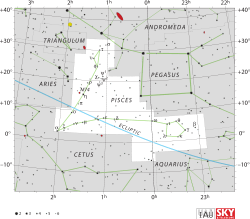Mu Piscium
Mu Piscium (μ Piscium) is a solitary,[8] orange-hued star in the zodiac constellation of Pisces. It is visible to the naked eye with an apparent visual magnitude of 4.84.[2] Based upon an annual parallax shift of 10.73 mas as seen from Earth,[1] it is located about 304 light years from the Sun. Given this distance, it has a relatively high proper motion, advancing 296 mas per year across the sky.[9]
 | |
| Observation data Epoch J2000.0 Equinox J2000.0 (ICRS) | |
|---|---|
| Constellation | Pisces |
| Right ascension | 01h 30m 11.11444s[1] |
| Declination | +06° 08′ 37.7577″[1] |
| Apparent magnitude (V) | +4.84[2] |
| Characteristics | |
| Spectral type | K4 III[2] |
| B−V color index | 1.38[2] |
| Astrometry | |
| Radial velocity (Rv) | +34.19[2] km/s |
| Proper motion (μ) | RA: +292.00[1] mas/yr Dec.: −45.95[1] mas/yr |
| Parallax (π) | 10.73 ± 0.19[1] mas |
| Distance | 304 ± 5 ly (93 ± 2 pc) |
| Absolute magnitude (MV) | −0.37[3] |
| Details | |
| Mass | 1.25[2] M☉ |
| Radius | 37[4] R☉ |
| Luminosity | 186[2] L☉ |
| Surface gravity (log g) | 2.07[5] cgs |
| Temperature | 4,126±27[2] K |
| Metallicity [Fe/H] | −0.39[3] dex |
| Rotational velocity (v sin i) | 1.0[6] km/s |
| Age | 5.57[2] Gyr |
| Other designations | |
| Database references | |
| SIMBAD | data |
This is an evolved K-type giant star with a stellar classification of K4 III.[2] It has an estimated 1.25[2] times the mass of the Sun and, at the age of 5.6 billion years, has expanded to about 37[4] times the Sun's radius. From this enlarged photosphere, it is radiating 186[2] times the Sun's luminosity at an effective temperature of 4,126 K.[2] It has a magnitude 12.02 visual companion at an angular separation of 209.30 arc seconds along a position angle of 298°, as of 2012.[10]
Naming
In Chinese, 外屏 (Wài Píng), meaning Outer Fence, refers to an asterism consisting of refers to an asterism consisting of μ Piscium, δ Piscium, ε Piscium, ζ Piscium, ν Piscium, ξ Piscium and α Piscium. Consequently, the Chinese name for μ Piscium itself is 外屏四 (Wài Píng sì, English: the Fourth Star of Outer Fence.)[11]
References
- van Leeuwen, F. (2007), "Validation of the new Hipparcos reduction", Astronomy and Astrophysics, 474 (2): 653–664, arXiv:0708.1752, Bibcode:2007A&A...474..653V, doi:10.1051/0004-6361:20078357.
- Luck, R. Earle (September 2015), "Abundances in the Local Region. I. G and K Giants", The Astronomical Journal, 150 (3): 23, arXiv:1507.01466, Bibcode:2015AJ....150...88L, doi:10.1088/0004-6256/150/3/88, 88.
- Ryon, Jenna; et al. (August 2009), "Comparing the Ca ii H and K Emission Lines in Red Giant Stars", Publications of the Astronomical Society of the Pacific, 121 (882): 842, arXiv:0907.3346, Bibcode:2009PASP..121..842R, doi:10.1086/605456.
- Pasinetti Fracassini, L. E.; et al. (February 2001), "Catalogue of Apparent Diameters and Absolute Radii of Stars (CADARS) – Third edition – Comments and statistics", Astronomy and Astrophysics, 367 (2): 521–524, arXiv:astro-ph/0012289, Bibcode:2001A&A...367..521P, doi:10.1051/0004-6361:20000451.
- Luck, R. Earle; Heiter, Ulrike (June 2007), "Giants in the Local Region", The Astronomical Journal, 133 (6): 2464–2486, Bibcode:2007AJ....133.2464L, doi:10.1086/513194.
- De Medeiros, J. R.; et al. (November 2000), "Rotation and lithium in single giant stars", Astronomy and Astrophysics, 363: 239–243, arXiv:astro-ph/0010273, Bibcode:2000A&A...363..239D.
- "mu. Psc". SIMBAD. Centre de données astronomiques de Strasbourg. Retrieved 2017-07-25.
- Eggleton, P. P.; Tokovinin, A. A. (September 2008), "A catalogue of multiplicity among bright stellar systems", Monthly Notices of the Royal Astronomical Society, 389 (2): 869–879, arXiv:0806.2878, Bibcode:2008MNRAS.389..869E, doi:10.1111/j.1365-2966.2008.13596.x.
- Lépine, Sébastien; Shara, Michael M. (March 2005), "A Catalog of Northern Stars with Annual Proper Motions Larger than 0.15" (LSPM-NORTH Catalog)", The Astronomical Journal, 129 (3): 1483–1522, arXiv:astro-ph/0412070, Bibcode:2005AJ....129.1483L, doi:10.1086/427854.
- Mason, B. D.; et al. (2014), "The Washington Visual Double Star Catalog", The Astronomical Journal, 122: 3466–3471, Bibcode:2001AJ....122.3466M, doi:10.1086/323920.
- (in Chinese) AEEA (Activities of Exhibition and Education in Astronomy) 天文教育資訊網 2006 年 5 月 19 日